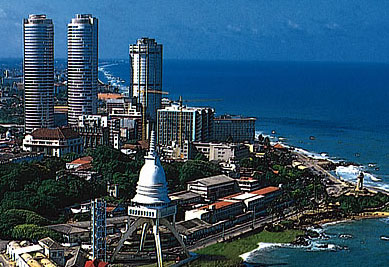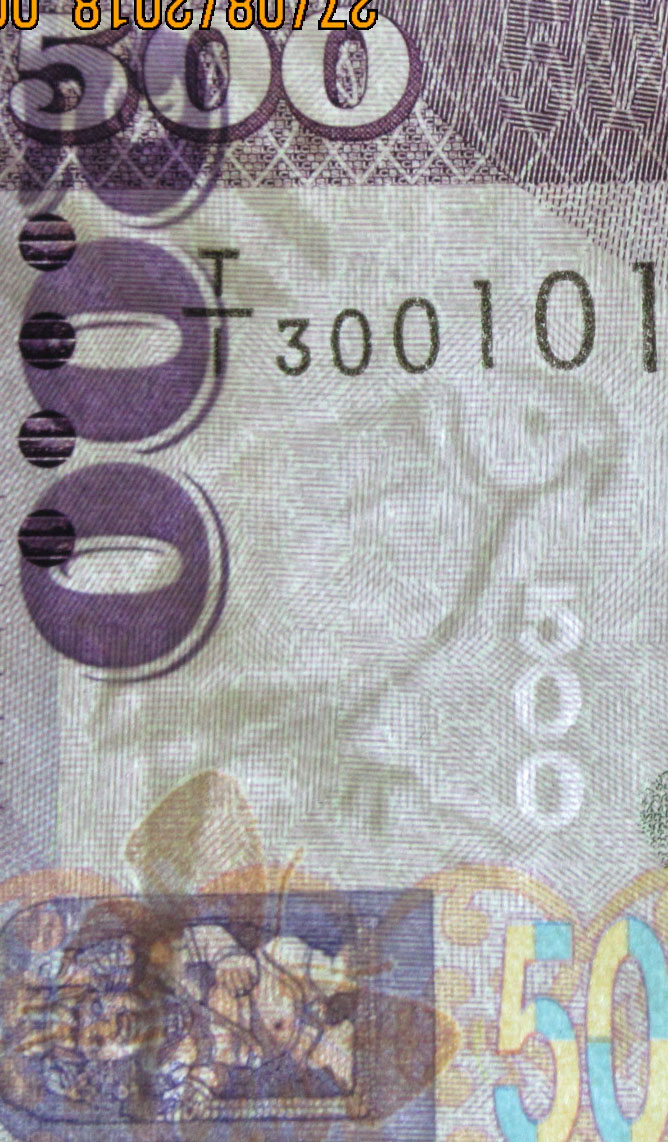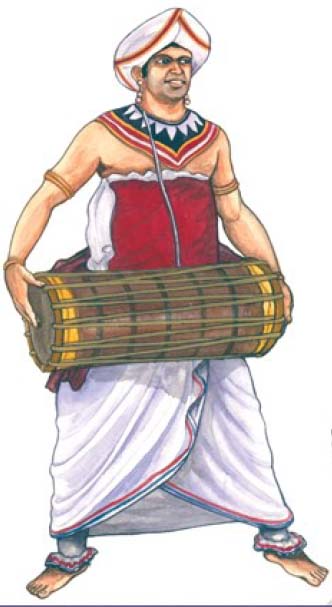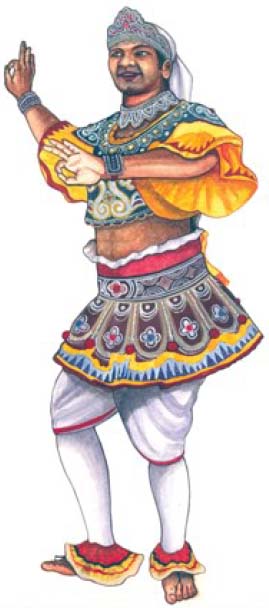

2010 - 2021
Sri Lanka
500 Rupee note
Development, Prosperity and Dancers
The Central Bank of Sri Lanka
(CBSL) issued,
for circulation, a new series of currency notes on the theme
"Development, Prosperity and Sri Lanka Dancers" on 2011 February 4th,
dated 2010-01-01.

| 
|
Click image to see Note Security under UltraViolet illumination
Front: Landscape
An artist's impression of WORLD TRADE CENTRE AND BANK OF CEYLON
HEADQUARTERS in the city of Colombo and a view of the ancient
Buddhist temple Lankathilaka Viharaya at Kandy to upper right.
Illustrated are
the Sri Lanka bird Emerald Collared Parakeet (Layard's Parakeet)
to the right, and
the butterfly, Ceylon Indigo Royal to the lower left.
Sri Lankan Lion with sword facing left at upper right.
|
Numeric 500 at upper left and lower right.
At bottom center the value
රුපියල් පන්සියයයි in Sinhala,
ஐந்நூறு ரூபாய் in Thamil
and FIVE HUNDRED RUPEES in English, of decreasing font size.
ශ්රී ලංකා මහ බැංකුව in Sinhala at Top center, with smaller
இலங்கை மத்திய வங்கி in Thamil
and English CENTRAL BANK OF SRI LANKA on next line.
Legality Legend in 3 lines
ශ්රී ලංකාණ්ඩුව වෙනුවෙන් නිකුත් කරන ලද මේ
මුදල් නෝට්ටුව ශ්රී ලංකාව ඇතුළත ඕනෑම මුදල් ගණනක්
ගෙවිම සඳහා නිතියෙන් වලංගුය
Facsimile signatures above මුදල් ඈමති, and
the මහ බැංකුවේ අධිපති,
with date YYYY-MM-DD below.
Size of digits in serial number increase in size.
Horizontal Black Serial number on upper left and vertical Red Serial
number on right.
Security Thread Starchrome with 2 mm width, which changes
colour from red to green with the letters CBSL RS500 and Mirror of same.
The location of the 2 mm Starchrome
strip varies in location over about
10 mm both horizontally and vertically as well as the letters visible
on strip. They don't represent variations of the note.
Back: Portrait
A drawing of a Thelme dancer
and a Yak Bera drummer. A Padmanidhi guard stone
is on the upper right on a vertical Band with a stylized floral motif,
Dvithva Liya Vela.
A map of Sri Lanka appears in the background centered to the left.
Numeric 500 at upper left and lower right.
රුපියල් පන්සියයයි in Sinhala,
ஐந்நூறு ரூபாய் in Thamil
and FIVE HUNDRED RUPEES in English, in 3 lines, of decreasing font size, at lower left.
 ශ්රී ලංකා මහ බැංකුව
in Sinhala,
இலங்கை மத்திய வங்கி in Thamil
and CENTRAL BANK OF SRI LANKA in English, in 3 lines, of decreasing font size at center upper left.
ශ්රී ලංකා මහ බැංකුව
in Sinhala,
இலங்கை மத்திய வங்கி in Thamil
and CENTRAL BANK OF SRI LANKA in English, in 3 lines, of decreasing font size at center upper left.
Printer Thomas De la Rue, Sri Lanka, in tiny text DE LA RUE
in bottom right.
Watermark: Cornerstone plus on left same image of Parakeet flipped to right, darker than
background with vertical 1000 lighter than background to it's right.
UV Printing: Random small fiber on both sides.
Front: Minimal. Highlighted Green square with numeric 500 in large Font,
upper right of center. Serial number in Green on left, Orange on right
Back: Limited highlight of Drummer and Dancer.
Security: See CBSL document Make Sure Your Currency Notes are
Genuine
 Latent image: Right of the top left numeric on front, the
Numeric value 500 written italic with horizontal lines
on a vertical lines background, both slightly tilted clockwise, as
seen on this 1200 dpi scan on right.
Image also show microprinting array of text CBSL.
Latent image: Right of the top left numeric on front, the
Numeric value 500 written italic with horizontal lines
on a vertical lines background, both slightly tilted clockwise, as
seen on this 1200 dpi scan on right.
Image also show microprinting array of text CBSL.
Replacement Notes See details with images for series in
*-Notes
| Predominant Color | : Purple | |
| Size | : 143 x 67 mm
|
| Serial Prefix | : T | |
| Replacement Prefix | : Z/5,Z/40
|
| Florescent Fiber | : Yellow | |
| Braille | : Four Dots
|
Front Landscape both old and New, with endemic Bird and Butterfly
designed by by Artist Mr Kelum Gunasekara.
Back portrait of traditional Sri Lankan drummer and a dancer
designed by Artist Sisira Liyanaarachchi.
Date on
BankNote | Finance Minister | CBSL Governor | First Serial # | Last Serial # | Mintage
in K | Replacement
Prefix
|
| 2010-01-01 | Mahinda Rajapaksa | Ajith Nivard Cabraal | T/1 000K | T/55 1000K | 50,000 | Z/5
|
| 2010-01-01 | Mahinda Rajapaksa | Ajith Nivard Cabraal | T/56 000K | T/115 1000K | 60,000 | Z/5
|
| 2015-02-04 | Ravi Karunanayake | A. Mahendran | T/116 000K | T/130 1000K | 15,000 | Z/5
|
| 2016-07-04 | Ravi Karunanayake | I. Coomaraswamy | T/131 000K | T/185 1000K | 55,000 | Z/40
|
| 2016-07-04 | Ravi Karunanayake | I. Coomaraswamy | T/186 000K | T/207 778K | 20,000 | SNIM-8.9%
|
| 2017-05-22 | Mangala Samaraweera | I. Coomaraswamy | T/207 779K | T/268 279K | 55,000 | SNIM-10%
|
| 2019-01-28 | Mangala Samaraweera | I. Coomaraswamy | T/268 280K | T/323 279K | 50,000 | SNIM-10%
|
| 2020-08-12 | Mahinda Rajapaksa | W. D. Lakshman | T/323 280K | T/334 530K | 10,000 | SNIM-12.5%
|
| 2021-09-15 | Basil Rajapaksa | Ajith Nivard Cabraal | T/334 531K | T/366 705K | 31,100 | SNIM-3.5%
|
| 2022-07-04 | Ranil Wickremesinghe | Nandalal Weerasinghe | T/367 000K | T/398 836K | 30,000 | SNIM-6.1%
|
A second order of 30 Million notes have been ordered of Rupees 500
notes has been placed with DeLaRue in 2024. (Reply to RTI 122/2024)
End prefix estimated about T/431 assuming 8% damage rate.
UV cured Post Print Varnish (UVPPV) coating was applied on Rs. 500/-
currency notes after 2016 from T/131 onwards and these notes are
slightly thicker. (Reply to CBSL RTI 0122/2024)
With or without the use of Replacement the First and Last serial is
not known to the last digit as it could be a replacement or
rejected. It is given to the First or last Brick (1000 or K notes)
From T/186 SNIM (Single Note Inspection Machine) was used.
Error notes removed, but not replaced with Z serial Replacements.
Packs have missing serial numbers.
Please Help Track Prefix+Serial when Date on Banknote change. Thanks.
Mintage of 20M, 55M and 50M notes stated in reply to RTI 0001/2020 is
1.78M(8.9%), 5.5M(10%) and 5M(10%) less than the difference of
Last - First Serial for these issues.
The increase of error rate from 0.2-0.3% replacements to about 10%
missing serial numbers with the adoption of SNIM by DeLaRue is
explained by more stringent quality control, but mainly because,
printed sheets are not quality checked before printing Serials.
Reply to RTI 0078/2021 states than no Rs500 banknotes were printed dated
2019-12-24 with MR+WDL Signatures.
The note scanned at 300 dpi and displayed above at 50 dpi
World Trade Center
World Trade Center, Colombo is an international business complex
complementing and supporting the existing services of private and
government agencies. It accounts for being the tallest completed
building in Sri Lanka. The building consists of two identical 40-
storeyed towers connected by a 4 storey retail block.
Lankathilaka Viharaya
Lankatilaka Viharaya is a Buddhist temple first built by King
Prakramabahu I, and later restored by King Vijayabahu IV. It was once
a five-storeyed high temple and decorated with flowers, creepers,
animals, birds and statues of deities. It has a peculiar architectural
design. The exterior walls are ornamented with delicate sculpture,
which depict various building of the Polonnaruwa era.
Sri Lanka Emerald Collared Parakeet (Layard's Parakeet) - Psittacula calthropae
Sri Lanka Alu Girava (Sinhala)
Ilangai Naattu Kili (Thamil)
Layard's Parakeet is an endemic resident ot Sri Lanka. This bird is
renamed as Sri Lanka Emerald-collared Parakeet since 2008. It is
common in forests, gardens, mainly in high country and forested humid
areas of low country. It is a green parakeet 30 cm long including the
tail up to 13 cm, with a bluish-grey head and back, separated by a
green collar.
The Ceylon Indigo Royal - Tajuria arida
Hela Neela Paramaya (Sinhala)
The Ceylon Indigo Royal is endemic to Sri Lanka and is found in the
low country wet zone. Wings of the male are dull frosted greyish blue
in colour. This species is categorized as critically endangered by the
IUCN.
Padmanidhi Guard Stone
The dwarf figures known as yaksas or bahirawas were used
in place of the Pot of Plenty. These figures represent two
yaksas vested with the responsibility of protecting the wealth
of god Kuvera that is said to be stored in the ocean. The
headdresses of the yaksa figures of some guard stones had been
designed in the shape of Sankha (conch) or Padma
(lotus). These sculptures were used with the belief that they provide
protection to the building. The best examples of Padma guard
stone are at Abhayagiri stupa at Anuradhapura and at the entrance to
the palace of Vijayabahu I.
Dvithva Liya vela
Traditional Sinhalese art has a floral motifs depicted with two
similar creepers called Dvithva liya vela. These flower bands are
combined or run parallel to each other in a regular pattern.

 Thelme Netuma
Thelme Netuma
Thelme Netuma (Thelme Dance) belongs to the ritual of Devol
Maduwa, which is performed to propitiate a deity known as
Devol. The Theirne Netuma is a pure rhythmical and
classical dance form of Sri Lanka Low Country dances. The main drum
used is the Yak Beraya.
Yak Beraya
Yak Beraya (Ruhunu Beraya, Devol Beraya
or Pahatharata Beraya) is the traditional drum which accompanies Sri
Lanka Low Country dances. This instrument is a long cylindrical drum
and is played with both hands.
Text edited from Press Releases of the CBSL.
For collected details of the images on this Banknote see
NotesCollector.





 Latent image: Right of the top left numeric on front, the
Numeric value 500 written italic with horizontal lines
on a vertical lines background, both slightly tilted clockwise, as
seen on this 1200 dpi scan on right.
Image also show microprinting array of text CBSL.
Latent image: Right of the top left numeric on front, the
Numeric value 500 written italic with horizontal lines
on a vertical lines background, both slightly tilted clockwise, as
seen on this 1200 dpi scan on right.
Image also show microprinting array of text CBSL.
 Thelme Netuma
Thelme Netuma